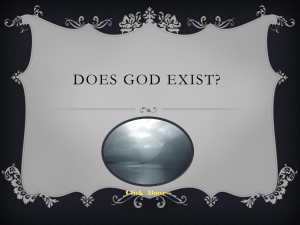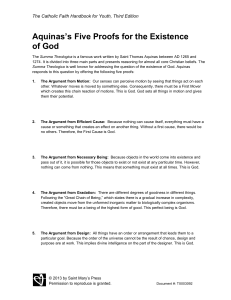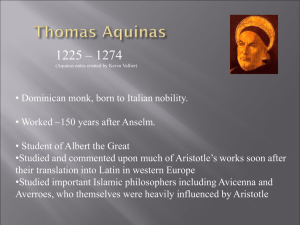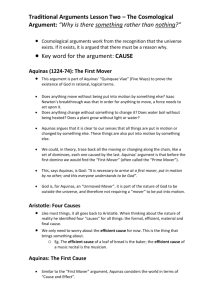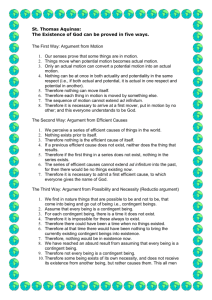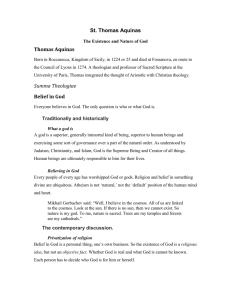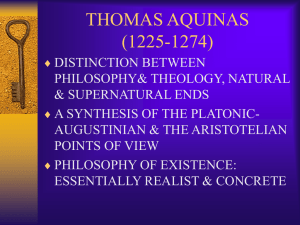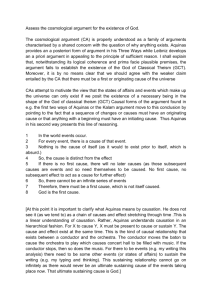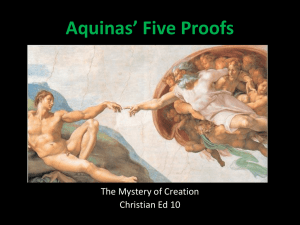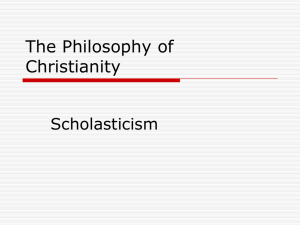The main difference between the Kalam cosmological argument and
advertisement
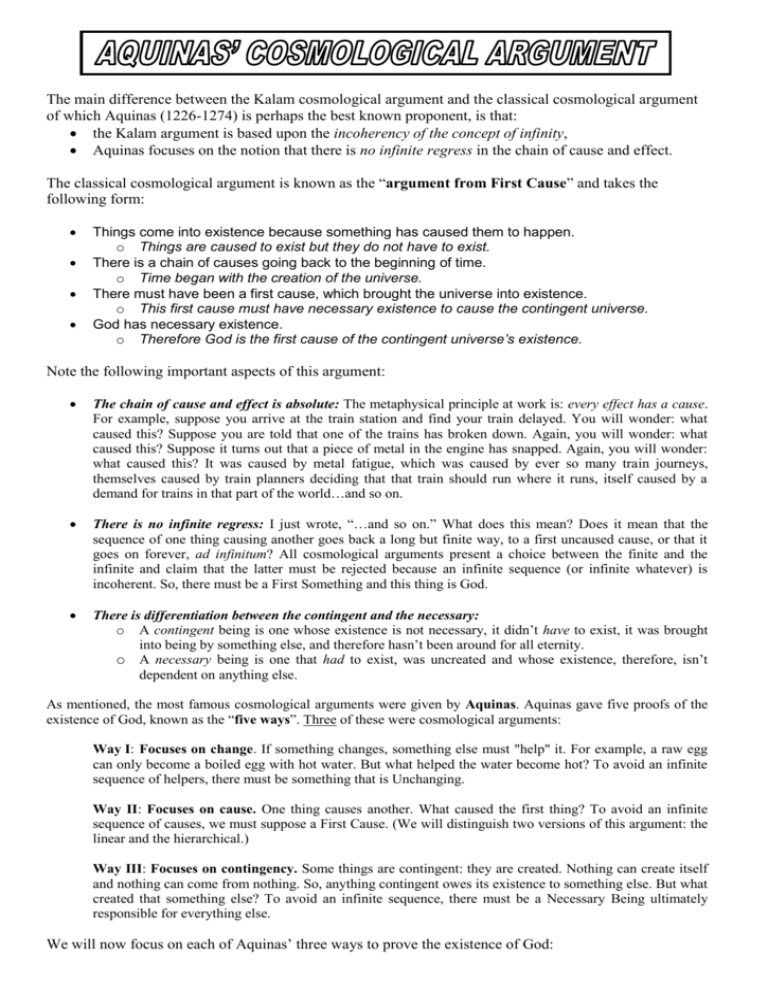
The main difference between the Kalam cosmological argument and the classical cosmological argument of which Aquinas (1226-1274) is perhaps the best known proponent, is that: the Kalam argument is based upon the incoherency of the concept of infinity, Aquinas focuses on the notion that there is no infinite regress in the chain of cause and effect. The classical cosmological argument is known as the “argument from First Cause” and takes the following form: Things come into existence because something has caused them to happen. o Things are caused to exist but they do not have to exist. There is a chain of causes going back to the beginning of time. o Time began with the creation of the universe. There must have been a first cause, which brought the universe into existence. o This first cause must have necessary existence to cause the contingent universe. God has necessary existence. o Therefore God is the first cause of the contingent universe’s existence. Note the following important aspects of this argument: The chain of cause and effect is absolute: The metaphysical principle at work is: every effect has a cause. For example, suppose you arrive at the train station and find your train delayed. You will wonder: what caused this? Suppose you are told that one of the trains has broken down. Again, you will wonder: what caused this? Suppose it turns out that a piece of metal in the engine has snapped. Again, you will wonder: what caused this? It was caused by metal fatigue, which was caused by ever so many train journeys, themselves caused by train planners deciding that that train should run where it runs, itself caused by a demand for trains in that part of the world…and so on. There is no infinite regress: I just wrote, “…and so on.” What does this mean? Does it mean that the sequence of one thing causing another goes back a long but finite way, to a first uncaused cause, or that it goes on forever, ad infinitum? All cosmological arguments present a choice between the finite and the infinite and claim that the latter must be rejected because an infinite sequence (or infinite whatever) is incoherent. So, there must be a First Something and this thing is God. There is differentiation between the contingent and the necessary: o A contingent being is one whose existence is not necessary, it didn’t have to exist, it was brought into being by something else, and therefore hasn’t been around for all eternity. o A necessary being is one that had to exist, was uncreated and whose existence, therefore, isn’t dependent on anything else. As mentioned, the most famous cosmological arguments were given by Aquinas. Aquinas gave five proofs of the existence of God, known as the “five ways”. Three of these were cosmological arguments: Way I: Focuses on change. If something changes, something else must "help" it. For example, a raw egg can only become a boiled egg with hot water. But what helped the water become hot? To avoid an infinite sequence of helpers, there must be something that is Unchanging. Way II: Focuses on cause. One thing causes another. What caused the first thing? To avoid an infinite sequence of causes, we must suppose a First Cause. (We will distinguish two versions of this argument: the linear and the hierarchical.) Way III: Focuses on contingency. Some things are contingent: they are created. Nothing can create itself and nothing can come from nothing. So, anything contingent owes its existence to something else. But what created that something else? To avoid an infinite sequence, there must be a Necessary Being ultimately responsible for everything else. We will now focus on each of Aquinas’ three ways to prove the existence of God: Aquinas’ First Way The Way From Change: Things Can Only Change With The Help Of Other Things. ‘The first and more manifest way is the argument from motion. It is certain, and evident to our sense, that in the world some things are in motion. Now whatever is moved is moved by another, for nothing can be moved except it is in potentiality to that towards which it is moved; whereas a thing moves inasmuch as it is in act. For motion is nothing else than the reduction of something from potentiality to actuality. But nothing can be moved from a state of potentiality to actuality, except by something in a state of actuality... it is therefore impossible that in the same respect and in the same way a thing should be both mover and moved i.e. that it should move itself. Therefore, whatever is moved must be moved by another. If that by which it is moved must itself be moved, then this also needs to be moved by another, and that by another again. But this cannot go on to infinity, because then there would be no first mover, and consequently, no other mover, seeing as subsequent movers move only inasmuch as they are moved by the first mover; as the staff moves only because it is moved by the hand. Therefore it is necessary to arrive at the first mover, moved by no other; and this everyone understands to be God. ’ The argument in terms of the changing of properties or qualities: Aquinas’s First Way appeals to the distinction between actuality and potentiality. Let us use the example of a raw egg sitting in my fridge. It is actually raw – raw at this precise moment. If I wanted to, I could put it in some boiling water and make myself a hard-boiled egg. The verb “could” here indicates potential. The egg is potentially a hard-boiled egg. It could become a hard-boiled egg. Then again, I could choose to poach it. So it is also potentially a poached egg. Indeed, it is potentially lots of things, but there are many things it could never be. The egg could never be a space-rocket or the next President of the United States. The potentiality of a thing is inherent within it. Furthermore, in order for it to achieve the potential, it needs an external (and actual) thing to affect the change. It can’t change itself as the distinctions between the potential and actual would collapse – e.g. a log of wood has the potential to be hot, but needs fire to make it actually hot. It can’t do this itself as otherwise the wood would already be hot and no change will have occurred. The point Aquinas is trying to make is this: (1) In order to convert something that is potentially X into something actually X, you need an external force that is actual to effect the conversion. So… let us suppose I want to make a hard-boiled egg. In order to do this, I need some boiling water. But I need some actual boiling water. Merely possible boiling water can’t boil anything. So, (1) is a principle about change. It is saying that things don’t change by themselves but that they need helpers, external forces to cause the change. Now, my actual boiling water was once cold water. It was actually cold and potentially boiling. To make it boiling I need to apply heat: actual heat. The heat in question was a gas flame. But that flame was once simply gas that was actually unlit but potentially lit. I needed an actual match to light it. Aquinas is therefore arguing that each time there is change, there must be an actual external force and that that actual external force must be as it is through being changed by another actual external force, and so on: [Actual egg + external force: hot water boiled egg] [Actual cold water + external force: gas flame hot water] [Actual gas + external force: actual flame actual gas flame] … and so on. Everything that is actual was once potential and made to be actual by an external force that also was once potential and made to be actual. This chain of such dependencies, an actuality-potentiality chain, eventually leads to the Prime Mover – God, who is eternally actual and needs no external force to effect such change. The argument in terms of the movement from one place to another: You will notice in the quotation that Aquinas talks about motion, not change. Motion is just a special form of change – a change of place – and it is clear from other things he says that Aquinas is talking about all sorts of change when he talks about motion. But let us consider an argument just in terms of motion Motion is the act of changing location: moving from one place to another. I am actually in Richmond-uponThames College but potentially in Rome. To get there, I need the help of actual things external to myself: food to give me energy, a taxi to the airport, a plane, and so on. So, we could read (1) as also saying: (1) In order to convert something potentially in one location X actually in that location X (i.e. to get it to move), you need something actual to effect the conversion. Again, the Aquinas’ argument is that such an actuality-potentiality chain cannot be infinitely long and so there must be a first actual cause for everything in the chain. Aquinas’ first way, then, is an argument that takes the following form: (1) (2) (3) (4) (5) In order for Y to move/change (for some potential to be actualised), it needs to be moved/changed by some actual X. Either the actuality-potentiality chain with X-Y in it has a First Actual Thing or it goes back forever and is thus infinitely long. It cannot be infinitely long. So, the actuality-potentiality chain has a First Actual Thing, also known as a Prime Mover. This Prime Mover is God. AQUINAS’ FIRST WAY IN SUMMARY: The Way from Change Motion in two senses: • movement from one place to another • sense of change of quality or quantity Things contain both potentiality and actuality: o Potentiality – the inherent but undeveloped capabilities and the possibilities of someone or something for development or change. o Actuality – a state of being, the reality of something at this moment in time. When anything changes or moves, it moves from its actual state to a state that was merely potential, and in doing so, such motion makes that potential state actual, meaning it ‘realises its potential’. In order to convert something that is potentially X into something actually X, you need something that is external to that thing, and that is actual itself, to cause the conversion. But how did that external force become actual? Its potentiality was realised by yet another external force. This chain of dependencies is an actual-potentiality chain. And since it cannot be infinitely long, there must be a first actual thing, a First Mover that set the chain in motion. That First Mover is God – eternal in its actuality, needing nothing else to make it so. Aquinas’ Second Way The Way from Causation: Where One Thing Causes Another, There Must Be a First Cause “The second way is from the nature of efficient cause. In the world of sensible things we find there is an order of efficient causes. There is no case known (neither is it, indeed possible) in which a thing is found to be the efficient cause of itself; for so it would be prior to itself, which is impossible. Now in efficient causes it is not possible to go on to infinity, because in all efficient causes following in order, the first is the cause of the intermediate cause, whether the intermediate cause be several, or one only. Now to take away the cause is to take away the effect. Therefore, if there be no first cause among efficient causes, there will be no ultimate, or intermediate, cause. But if in efficient causes it is possible to go on to infinity, there will be no first efficient cause, neither will there be an ultimate effect, nor any intermediate efficient causes; all of which is plainly false. Therefore it is necessary to admit a first efficient cause, to which everyone gives the name of God.” An efficient cause is what we would ordinarily call a ‘cause’ – an event that brings about a certain result. The result being its ‘effect’. Our world is one in which one event (the cause) produces another (the effect). And Aquinas here argues that there cannot be an infinitely long causal chain of events. TWO TYPES OF CAUSATION First need to distinguish two dimensions of causation: linear causation and hierarchical causation. Linear causation: one thing after another. I come home and turn on the light. This lights up the hall. The light disturbs a moth and makes it fly out of the window. This startles the cat on the window-sill. This causes it to jump down. This startles the dog next door. This causes him to bark. This causes the neighbours to wake up. In this little story, one thing leads to another. The events are like snooker balls. One hits another and sets it off. What makes this linear causation is that once the cause has caused the effect, it can cease to exist. Once the light has caused the moth to move, it can cease to exist. I can turn the light off immediately and the sequence of events will still roll on. Dominoes is another good example. Hierarchical causation: one thing at the same time as another. A conductor moves his baton. The orchestra plays. There is music in the hall. The audience are transported to another place by its sublime beauty. The conductor causes the orchestra to play which causes the music which causes the good mood. Here causation is hierarchical. A cause must continue to exist for its effect to exist. If the conductor stops then the orchestra stops. If the orchestra stops then the music stops. If the music stops, the mood stops. In sum, where we have linear causation, the cause can produce the effect and then cease to exist whereas where we have hierarchical causation, the cause produces the effect only so long as it continues to exist. Aquinas believed both occurred at the same time (e.g. in the orchestra example, linear causation occurs with the players hearing each other and affecting their playing), but the primary foundation for linear causation was hierarchical causation. His argument is then as follows: (1) (2) (3) (4) (5) (6) Every effect has an (efficient) cause Either the causal chain is infinitely long or it is finitely long. It cannot be infinitely long. So, it must be finitely long. If it is finitely long, there was a First Event. This First Event was the Creation of the universe by God. Why can’t causation be infinitely long? An explanatory analogy for premise (3): Consider a multi-storey building such as a skyscraper. Each floor supports the floor above it. So, the tenth floor is supported by the ninth floor but it also needs the eighth floor as that supports the ninth floor. It also needs the seventh floor as that supports the eighth floor…and so on down to the ground floor, which needs no support. A universe without a first cause would be like skyscraper without a foundation. How could such a thing stay upright? Aquinas is then arguing that just as it is absurd that our building can carry on downwards forever, lacking a foundation, so too is it absurd that a hierarchical chain of causes and events could carry on forever. The foundation for all chains of cause and effect in the universe (in a sense, the universe itself) is God. The point of both the orchestra example and the skyscraper example is that of God’s continued involvement. Not only did God set the chain in motion, but he sustains it. Aquinas believed that the world only existed because God continually kept sustaining its existence: The world is like music and God like a musician. God is external to the chains of cause and effect. Also, our multi-storey building is made up of many floors that depend on each other. Each floor also depends on the bricks and cement holding it together. The bricks and cement each depend for their continued existence on God. God must always be there to keep the basic things continuing to exist. Aquinas believed that nothing could exist from one moment to the next unless it was sustained. God is the exception. We have a different metaphysical perspective these days. We don’t think that ordinary things like bricks and tables need something to make them continue to exist. They need something to come into existence (such as a brick-maker or a carpenter) and they need something to go out of existence (such as an explosion or a fire) but once created, nothing more needs to be done. Aquinas viewed the world differently. For him, as for all the philosophers of his time, it just didn’t make sense to say that ordinary things could go on existing all by themselves. Nothing happens without the will of God. AQUINAS’ SECOND WAY IN SUMMARY: The Way from Causation An efficient cause – is an event that brings about an effect. Nothing can be the cause of itself as this would mean it would have had to exist before it existed. It is a logical impossibility for something to be prior to itself. This means everything is caused by something else, but the causal relation is hierarchical – the chain of cause and effect is absolute, unbreakable, with each event dependent on the other. There must there be a first, uncaused, cause, since efficient causes follow in such a hierarchical order (there is a first cause which causes the intermediate cause which causes the ultimate cause), and as such there has to be a foundation that sustains the chain. Hence there is no infinite regress. God sustains the chain of causation from his position external to the universe, God’s will permeates every event. Aquinas’ Third Way The Way From Contingency: Contingent Beings Ultimately Depend On A Necessary Being. ‘The third way is taken from possibility and necessity, and runs thus. We find in nature things that are possible to be and not to be, since they are found to be generated, and to be corrupted, and consequently, it is possible for them to be and not to be. But it is impossible for these always to exist, for that which can not-be at some time is not. Therefore, if everything can not-be, then at one time there was nothing in existence. Now if this were true, even now there would be nothing in existence, because that which does not exist begins to exist only through something already existing. Therefore, if at one time nothing was in existence, it would have been impossible for anything to have begun to exist; and thus even now nothing would be in existence - which is absurd. Therefore, not all beings are merely possible, but there must exist something the existence of which is necessary. But every necessary thing either has its necessity caused by another, or not. Now it is impossible to go on to infinity in necessary things which have their necessity caused by another, as has already been proved in regard to efficient causes. Therefore, we cannot but admit the existence of some being having of itself its own necessity, and not receiving it from another, but rather causing in others their necessity. This all men speak of as God.’ The Third Way turns on the difference between contingency and necessity. A contingent being is one whose existence is not necessary. It therefore hasn’t been around for all eternity. So, it must have been created or generated. Similarly, contingent beings don’t last forever. So, it must eventually be destroyed (or ‘corrupted’, as Aquinas puts it). Nothing can come out from nothing: If we go back many billions of years, many of the contingent things around today would not yet have been born, such as the Earth. Since contingent things can’t create themselves, if we keep going back eventually we’d bypass the birth of all contingent things. There would then be nothing. It was widely held that nothing could come from nothing (ex nihilio nihil fit). So, it is impossible that the universe could have come about by itself. So, it needs a creator. A necessary being, who wasn’t created, who is eternal, whose non-existence is impossible. Also, no infinite regress: Why couldn't we just have a sequence of one thing creating another back ad infinitum? As with Way I and Way II, this would be an unacceptable infinite sequence. To say that Z exists because Y created it and Y exists because X created it...and so on is to suppose we can have an infinite skyscraper without foundations. God is the source of necessary being, rather than simply a necessary being itself, since Aquinas also believes that there are angels who are necessary. The necessary beings angels however, are seen to be created by God, so God is the necessary source of both necessary and contingent beings. AQUINAS’ THIRD WAY IN SUMMARY: The Way from Contingency (1) (2) (3) (4) (5) (6) (7) (8) Every contingent thing must have been created at some point. A contingent thing can be created either by another contingent thing or a necessary thing. This process must go back only finitely far (because hierarchical causation shows infinite regress is absurd) Suppose the process goes back to a First Contingent Being. Then, before it there would have been nothing. Nothing comes from nothing. So there can't be a First Contingent Being. So the universe must have been created, by a First Necessary Being: God
